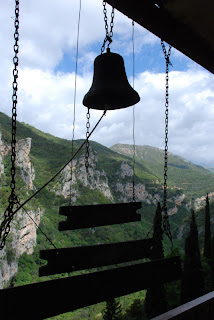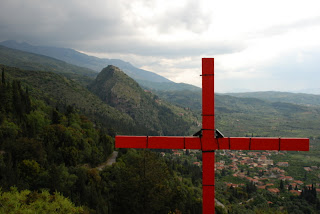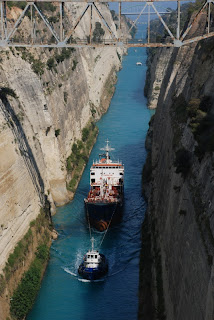




I went to see Eleni, the campsite owner, to pay for our four nights. I had negotiated, with difficulty, the price down from €24 to €20 but when I gave her the €80 she insisted on giving me back €10 with a big smile and a big 'thank you'. However that wasn't enough. We were just filling the van with water when Eleni appeared on her trademark tricycle clutching a bottle of green olives from her garden. They were in strong brine with a layer of oil floating on top. We were given strict instructions as to how to prepare them for eating: remove the olives and soak in water overnight; slit the olives and soak in vinegar for eight hours. Can't wait to try them but we will probably leave them until we are back in England and want to savour the flavour of Greece.
We took Henrietta into the village and parked up to do some shopping. First on the list was another visit to the Evi-Evan wine cellar to buy some more olive oil. It was Maria's day off but her daughter (Eleni?, the engaged one rather than the married one) was there and she was able to confirm that the road that we intended to take south was asphalted the whole way.
Taking a road south west out of Aghios Andreas we headed for Kastanitsa, climbing steeply and passing only bee-keepers tending to their hives . This was Maria's home village where she lived before she emigrated to Canada and she told me that it is very pretty. She was quite correct, it really is lovely. Traditional houses spill down the hillside that is topped by the ruins of a tower (alt. 900m) that commanded views down the valley and over to the sea. The view was very hazy today but we could just make out the outlines of islands (Spetses, Spetsopoula and Hydra) and the Didyma Peninsular of the mainland. The village was deserted, a mixture of tasteful modern, renovated old and semi-ruined houses all with traditional, very heavy, stone-tiled roofs. We found the main square well hidden amongst houses on the ridge and chatted to a very friendly taverna owner. We were the only people there and he explained that almost all of the houses were holiday homes, many owned by families who originated from Kastanitsa but had moved away to find jobs. He said that it is very quite at this time of year but in July and August it is crazy and the square and his taverna are packed. He wished us a good holiday and we returned to Henrietta, grateful that we didn't have a larger motorhome as we negotiated a sharp, narrow bend in the village before heading south.
Just above Kastanitsa (yes, climbing again) we travelled through a sweet chestnut forest with chestnuts still littering the road. Then came miles of lovely pine forest with mountains either side. We climbed to about 1500 metres before descending to the village of Tsintzina where our excellent Anavasi 1:50,000 map showed a large number of marked trails. We saw a number of signs marking the trails from the road and I think that this would be a very good centre for walking. It was here that we came across the first signs of the very serious forest fires of 2007(?). A large sign announced that the European Union is funding a project to rehabilitate the forests of Mount Parnon and it soon became clear how big a project this must be. We went through at least 11 miles of burnt forest where the undergrowth was recovering but no new trees were growing. Very occasionally a few trees had survived the fire but otherwise only bare, blackened trunks rose from the ground. We had planned to wild camp in this area but it wasn't very attractive so we headed on to Kalithea that had been spared from the fire and found a pull-in just south of the village in sight of the ruined but impressive 'Pirgos', a tower with a high-walled enclosure.
Photos: A sight that we have seen many times on this sojourn – bee-keepers at work; Kastanitsa viewed from the ruins of the Kapsambeli Tower; The only traffic that we saw in Kastanitsa passes through the square; Not all of the houses in Kastanitsa were renovated but this one has got a satellite dish!; This farmhouse was rebuilt after being destroyed by the forest fires, the evidence of which can be seen all around it.












































